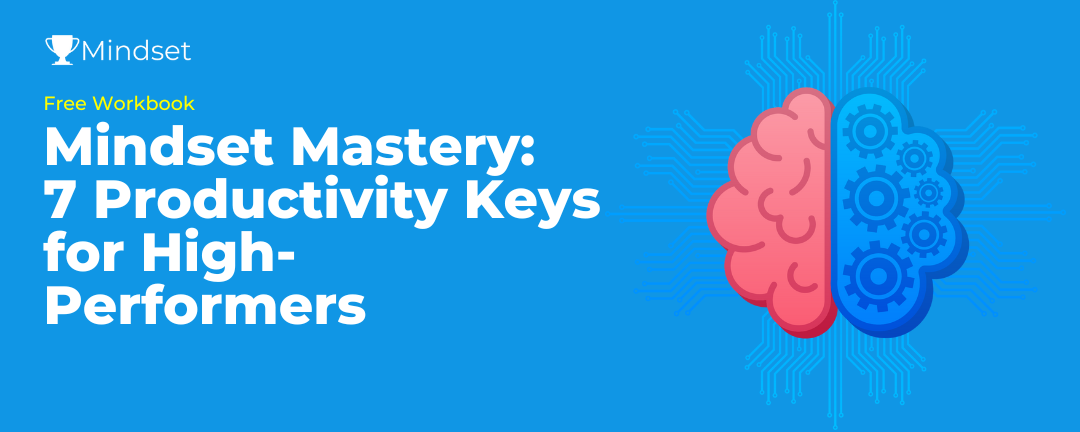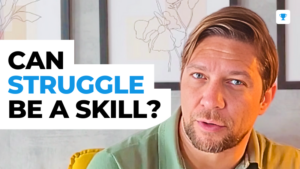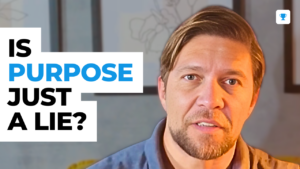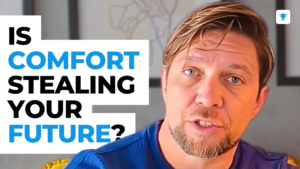
.
✅ FREE WORKBOOK ACCESS: Mindset Mastery: 7 Productivity Keys For High-Performers
Listen to the podcast version:
They call you inconsistent. Overreactive. Unstable. All over the place…
but they don’t really know what you’re capable of, do they?
The worst part? it’s not what they say. It’s when you start to believe it.
- You miss a deadline… and feel like a fraud.
- You cancel plans… and wonder if you’re unreliable.
- You break a promise… and start to wonder if they were right to doubt you all along.
And that kind of feeling? It doesn’t just sting. It sticks. It makes you question if you can really trust yourself.
And over time, you start hiding those feelings—even from yourself.
But hiding behind shame doesn’t make flaws disappear. It stores. It waits.
And it keeps you stuck in the version of you those flaws made you believe in.
That’s what I think psychologist and Holocaust survivor Edith Eger meant in her book The Choice when she said:
“You can’t heal what you don’t feel.”
But what if your flaws are not signs that something’s wrong with you?
What if they are signals—meant to be read, not buried?
If that’s the case, our whole idea about resilience might be wrong.
Maybe it’s not about being tougher than everyone else… but knowing what to do when things go off track—and how to come back, every time.
And if that’s true… maybe you’ve been blamed for the wrong reasons.
You were never broken.
You’ve just been missing the one thing that makes resilience possible.
Let’s fix that.
Stop Judging Yourself and Start Training Yourself
We live in a world obsessed with performance.
We’re trained to show up, work hard, push through, stay consistent. But no one has ever taught you how to come back after you’ve been knocked off.
- Not emotionally.
- Not mentally.
- Not even physically.
So you end up trying to power through with a drained battery, hoping discipline will carry you across gaps that actually require… healing.
Think about it—how often do you judge yourself for needing a break? How often do you expect your mind to keep performing even after it’s taken a hit?
You can have drive, discipline, ambition… and still fall apart if you don’t know how to come back from a hit.
So if you stop judging yourself and start training yourself instead, you don’t just heal. You gain resilience.
And one of the most powerful ways to do that is to start building trust in who you are becoming.
- But not blind trust.
- Not fake-it-‘til-you-make-it trust.
We’re talking about evidence-based trust.
Think about it… how do we build trust with anyone? We watch what they do, not what they say. And it’s the same with yourself.
You don’t build self-trust by repeating affirmations. You build it by showing up for yourself—especially after things fall apart.
You give yourself proof that even when you crash… you come back. And every time you do that, even in a tiny way, your identity updates.
And this identity shift? It compounds.
The more you bounce back, the more proof you gather. The more proof you gather, the more consistent you become.
You don’t just survive hard moments anymore. You learn from them.
You turn them into reference points. Evidence. Proof that this version of you knows what to do next.
Because once you start seeing resilience as a skill… You realize it’s all about building evidence that you already have the tools to get back to who you are.
You realize that…
Resilience is the capacity of being hurt without being wounded.
The Resilience System: A.R.M. Yourself
Ok, so… if that’s true, so resilience is nothing more than a system. And like any system—it can be built and optimized.
That might sound strange at first, especially if you’ve always seen resilience as this deep, inner strength.
But here’s something no one really talks about:
Everyone gets knocked down. Everyone spirals. Everyone reaches a point where the weight is too much. The difference is not in whether it happens—the difference is in what you do when it happens.
And that’s what makes this idea so powerful: You don’t have to be stronger. You just have to build a system that allows you to bounce back.
That’s what I think Angela Duckworth talks about in her book Grit when she makes the case that perseverance—and what most people think of as resilience—is not a personality trait, when she says:
“Grit is not just about intensity. It’s about consistency over time.”
And what could be better than a system to create that consistency? A system is something you can use over and over again in different situations.
So let’s break it down.
One simple way to build a resilience system is to remember this:
You can A.R.M. yourself.
A. R. M. And A.R.M. stands for:
- Awareness.
- Reset.
- Movement.
Three parts. That’s your system.
A — Awareness
Let’s start with Awareness because you can’t fix what you don’t see.
So what if the first act of resilience isn’t strength… but just noticing?
- Noticing when your energy shifts.
- Noticing the moment you disconnect.
- Noticing when you feel triggered.
Think about how often you override that signal. You feel off, but you keep pushing. You sense tension, but you pretend it’s fine. You lose focus, but you keep going instead of stopping to ask why.
But what if you didn’t wait until you were fully burned out to pay attention? What if you treated early signals like checkpoints, not interruptions?
That’s where Resilience starts. Awareness.
How do you do that?
Just stop yourself from reacting to something that’s triggering you. Give yourself a few seconds and focus on telling yourself how that situation is making you feel.
“I feel overwhelmed.”
“That’s making me angrier than I expected.”
“I’m feeling anxious.”
That’s Awareness. It’s the moment you stop running the pattern—and start observing it.
You haven’t fixed anything yet. But you’ve done the one thing most people never do. You’ve interrupted the spiral before it escalated.
R — Reset
The second part of the A.R.M. System of Resilience, remember A. R. M., is the “R”. That stands for Reset.
Without this reset, whatever you do will deepen the problem instead of solving it. And you’ve seen this before. People feel hurt by a situation and their next move makes it worse.
You can’t build a healthy response on top of a hijacked nervous system. You have to break the pattern first. Then you act.
In the Awareness stage, you took the first step, remember?
You gave yourself a few seconds to notice how the situation was making you feel.
- I feel overwhelmed.
- That’s making me angrier than I expected.
- I’m feeling anxious.
You brought Awareness to your emotions. Now, let’s use it to Reset.
We do that by turning that Awareness into a “why” question.
Why Am I feeling overwhelmed?
Why is this making me angrier than I expected?
Why Am I feeling anxious?
You’ll be surprised how quickly your mind responds to that.
The next step in the Reset stage is to give that response a name:
Why Am I feeling overwhelmed? This is perfectionism.
Why is this making me angrier than I expected? This is fear of judgment.
Why Am I feeling anxious? This is insecurity.
And here’s what’s wild: by doing that, your brain starts to calm down.
There’s actual neuroscience behind this.
In his book Social, Matthew Lieberman, explains a phenomenon called Affect Labeling.
Here’s what he found:
“When people labeled their emotions, activity in the amygdala decreased and activity in the right ventrolateral prefrontal cortex increased.”
So, when you name an emotion, you reduce activity in the amygdala, part of the brain that’s freaking out by trying to figure out what the heck is going on, and you increase activity in the the prefrontal cortex, the part of the brain that helps you make conscious decisions.
In plain language?
Naming the problem, or affect labeling, translates what’s hurting you into language you can use to counter what’s hurting you.
Because your subconscious mind doesn’t speak language. It speaks emotions. That’s a problem in and of itself because to solve a problem you need to know what problem you have.
And we use language to frame, identify, and interact with the world around us, including problems. Emotions are erratic, elusive, vague, extreme. They don’t make sense, we must make sense of them.
And once we do?
That’s the moment we take back control. Because now, you’re not reacting—you’re choosing. You’ve interrupted the spiral, made sense of the signal, and returned to yourself.
Now… it’s time to move
Not to escape the emotion, but to build something new on the other side of it.
M — Movement
That’s what the final stage of the A.R.M. System of Resilience, is for. “M” Stands for Movement.
And the first thing Movement must do is to answer the question: What’s the next move after the Reset?
The next move is to be honest. That’s the key.
Movement is not a reaction to how you feel. It’s a response to why you feel it.
That’s what being honest means.
You’re not following the emotion anymore. You’re following the reason behind it.
You already found that reason, remember?
You became aware of how you felt: “I feel overwhelmed.”
You turned your awareness into a “why” question: “Why do I feel overwhelmed?”
The answer emerged and you were able to frame it: “This is perfectionism.”
You brought your emotions to surface. You framed them. You did the Reset.
Movement is your answer to that Reset.
And James Clear puts it very clearly in Atomic Habits when he says:
“Every action you take is a vote for the type of person you want to become.”
And when that action is honest—aligned with what you uncovered in the reset—it’s no longer just movement.
It’s identity-building.
So how to find this honest move?
If the real issue is perfectionism in this example, maybe the honest move is to finish the thing without making it flawless.
Because the problem didn’t come from the task’s flaws. It started the moment your perfectionism was hurt.
That’s the why you felt triggered.
And that’s why the honest move isn’t to fix the task—it’s to face the belief behind it.
Honesty isn’t always comfortable. But it’s never weakness.
And when you take that step, you’re proving something to yourself: Even when I fall apart… I know how to get back on track and move forward.
And Brené Brown said something about that in her book The Gifts of Imperfection that stuck with me:
“You learn courage by couraging.”
In other words, you don’t build courage by thinking about it. Or waiting for it. You build it by showing up—especially when things feel messy or uncertain.
It’s a loop. You act, you learn, you grow.
And over time, those little honest moves start to shape how you see yourself. That’s what resilience really is: An evidence-based opinion about yourself.
- Not willpower
- Not a strong personality
- Not an unshakable character
But undeniable evidence that you act from the why, not the wave.
You were never broken. You just never had the system.
But now you do.
You know what to be aware of.
You know how to reset.
You know how to move.
And more than that. You know how to trust yourself.
Resilience isn’t a personality. It’s a loop. A rhythm. A skill.
And every time you use it, you become someone you can count on.




